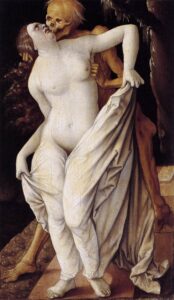Death and Sensuality
Tales of lust and darkness from then and now

Prologue
Love and death, eroticism and abolition; two entities, two conflicting symbols that nevertheless always find each other throughout time in order to form a contrasting, fervent couple. Consumed by absolute passion, where individuality is lost, love and death unite to become each other. And in their endless entanglement, they find themselves as only living for, and as, their contrasting opposite.

Chapter -3000
Once upon a time in a far, far land, there were Gods. Gods who governed and controlled every fragment of the world. Gods so powerful that murmuring their names could be enough to make one shiver.
Two of those Ancient Greek divinities were Eros – the God of graceful love, symbolizing the urge for life – and Thanatos – the God of death, embodying the urge of annihilation. Thanatos shares his Greek etymological root, “tha”, with another Greek word: thalamon, or nuptial chamber, thus associating himself not only with death and darkness, but with eroticism and consuming love as well.
In 1920, Sigmund Freud (1856-1939) introduced – and modernized – Eros and Thanatos to psychoanalysis in Beyond the Pleasure Principle, by relating them respectively to libido, or sex drives, and to destructive impulses, or death drives. In all living beings, these entities coexist and fight but, ultimately, they merge, making it impossible to distinguish them from one another. The separation line is blurred, softened; life inevitably leads to death, but death, in turn, gives meaning to life.

Chapter 1517
Centuries after the reign of Greek Gods, Niklaus Manuel Deutsch (1484-1530), a German Early-Reformation artist, made an engraving, which he named Der Tod und Das Mädchen or Death and the Maiden, where death and eroticism are seen embracing one another: She felt Death’s breath on her neck and as he lifted up her dress. She grabbed his hand, desperate to bring it closer to her lust. She fell into his caress, and they kissed. Fervently.
Death & the Maiden (D&M), as a multitude of art works were made with this exact name, became an artistic genre during the time of the Protestant Reformation. This was mostly due to the changed way of looking at the afterlife, where one was now imagined to have to account for their sins – the giving in to temptations – at the moment of passing. D&M artworks were in line with those Protestant views and aimed to portray the foolishness, futility and fleetingness of worldly passions. Sexual desire was therefore strongly related to death, as the pursuit of earthly pleasures might result in an eternity in hell.
Coming back to the 20th century, Freud argued that death was the ultimate pleasure as it was free from tension and lust. This could mean that if one restrained oneself while living, death would then come as a release, as one would finally reach exaltation.
Death and sensuality meet once more and in this moment of deliverance, they are one.

Chapter 2013
Uniting what at first glimpse might be understood as opposite is a practice humans seemingly can’t escape from. Like magnets, death and eroticism always sense one another’s presence. They always find a way to collide and embrace again and again. Yann Gonzalez, in his movie Les Rencontres d’Après Minuit (2013), offers those two entities a safe space to meet. A long, long time ago, war took Matthias away from Ali. Smoke surrounds her as she sits, mourning in front of Matthias’ grave. Behind her, a dark, elegant figure approaches:
“[ … ]
– I have never known a couple as luminous, as staggering as yours. Here is my offer: If I succeed at bringing Matthias back to life, I want to be a part of your love. I want you to be there for me as I will be there for you. I won’t be very demanding, but I want to watch you make love, take part in your pleasure and stay by your side like an old cat, tender and sexual.
– What a weird proposition. But it is understood. If Matthias comes back from the dead, we will be yours.
– And, like me, you will be gifted eternal life to assure we can savor our zealous youth together. [ … ]
– He is alive. Alive! My love… [ … ]
– Listen to me, both of you. Matthias’ life lays in your hands Ali; Your desire. Matthias needs to feel your desire shiver, tremble, no matter if this desire is stimulated by him or by others. [ … ]”
It all comes down to this: as long as Ali’s erotic desires are fulfilled, Matthias will stay in the realm of the living, by her side. That is the pact they made with Udo, or the grim Reaper. They are bonding lust to death, with Ali symbolizing the urge for life and Matthias, embodying death.

Epilogue
Throughout time, a pattern is drawn where opposites attract, copulate and dissolve into one another. Dichotomy becomes sameness. Consuming, magnetic passion is what unites these two ends of the spectrum: Sensuality & Death, Eros & Thanatos, sex & death drives, Tod & Mädchen, Ali & Matthias. These conflicting couples have found one another since the beginning of time, and will continue to do so in order to live happily ever after.
Designed by Giulia Cristofoli


